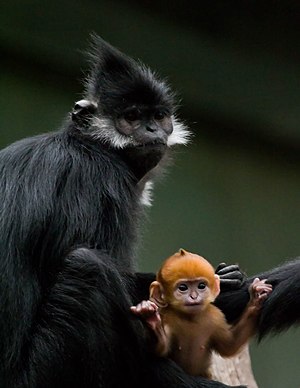Tonkin black langur
| Tonkin black langur | ||||||||||||
|---|---|---|---|---|---|---|---|---|---|---|---|---|

Tonkin black langur with young |
||||||||||||
| Systematics | ||||||||||||
|
||||||||||||
| Scientific name | ||||||||||||
| Trachypithecus francoisi | ||||||||||||
| ( Pousargues , 1898) |
The Tonkin black langur or Francois langur ( Trachypithecus francoisi ) is a species of primate from the slender monkey group (Presbytini). They were named after Auguste François (1857–1935) who, as the French consul in Longzhou ( Guangxi ), was the first western person to observe these animals.
features
Tonkin black langurs are slender, long-tailed primates. They reach a head body length of 47 to 64 centimeters and a tail length of 74 to 96 centimeters. Males are 6.5 to 7.2 kilograms heavier than females who weigh 5.5 to 6 kilograms. Their fur is predominantly black, with a white stripe extending from the corners of their mouths to their ears. The long head of hair on the top of the head is striking. The hands and feet are slender and the thumbs are very small.
distribution and habitat
Tonkin black langurs are native to southern China (provinces of Guangxi and Guizhou ) and northern Vietnam (in the Tonkin region that gives them their name ). Their habitat are equipped with rain or monsoon forests passed karst areas . The distribution area in Vietnam is highly fragmented and includes parts of the provinces Bắc Kạ , Cao Bằng , Hà Giang , Thái Nguyên and Tuyên Quang .
Lifestyle and diet
Tonkin black langurs, like all Old World monkeys, are active during the day, when they sleep they often retreat to hard-to-reach karst caves, especially in bad weather. During the day they mainly stay in the trees, where they move on all fours. They live in groups of 4 to 27 (usually around a dozen) animals made up of a male, several females and young animals. The females establish a hierarchy that is expressed in terms of access to food sources and mutual grooming , among other things .
These primates are herbivores that mainly eat leaves. They also eat fruits, flowers and buds. Like all slender monkeys, they have a multi-chambered stomach for better utilization of the plant food.
Reproduction
After a gestation period of around six to seven months, a single young is usually born. As with all crested langurs, it is orange in color and weighs around 0.5 kilograms. Not only the mother, but also the other females in the group look after the young. You pass it around, play with it, and wear it. When sexual maturity occurs - at the age of 4 to 5 years - the males have to leave their birth group.
threat
The main threat to the Tonkin langurs is the loss of their habitat through deforestation, and to a lesser extent hunting. In Vietnam, its area of distribution was badly affected by bombing and the use of defoliants during the Vietnam War . In Vietnam the total population should not be more than 500 animals, in China the number was estimated at 1,400 to 1,650 animals in 2003. Overall, the type of which is IUCN as ( "high risk" endangered ) listed.
Systematics
The François' langur forms with some other species within the genus of lutung the francoisi group whose representatives are all characterized by a predominantly black fur and mainly on the Indochina Peninsula live. The other species of the francoisi group are the Delacour black langur ( T. delacouri ), the Indochinese black langur ( T. Ebenus ), the Hatinh langur ( T. hatinhensis ), the southern black langur ( T. laotum ), the white-headed langur ( T . leucocephalus ) and the Cat-Ba-Langur ( T. poliocephalus ). Some of these species are sometimes considered subspecies of the Tonkin black langur.
literature
- Thomas Geissmann : Comparative Primatology. Springer-Verlag, Berlin et al. 2003, ISBN 3-540-43645-6 .
Web links
- Trachypithecus francoisi in the endangered Red List species the IUCN 2008. Posted by: Bleisch, B., Manh Ha, N., khat Quyet, L. & Yongcheng, L., 2008. Accessed on 25 March of 2009.
- Information on Theprimata.com
- Photos and information on arkive.org
